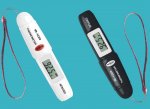Took longer to get back to this than I planned, but here ya go!
Ok, the first part of the test is done! I'm amazed. I made both targets, round & square. This post is for the the round targets only. I had made them and getting them exact sizes needed I had to respray another piece of foil for the square targets. Error possibility #1, diff paint thickness's. The round were much more closely related visually from the description of the visible beam and other listed characteristics on this forum. Lack of paint on the square ones or to much? I have no calibrated laser nor a true LPM. So what's the point? Well, if care is taken, you can get comparison results for changes made, between lasers, lens swapping gain or loss, even a fair portion of how much IR your green laser is putting out as a %.
Now lets be clear, the numbers I'm posting are the results of the multiplied temperature diff at the start, after 30 seconds lasing the center of the target, and then multiplied by 3.13. They seem uncannily close to what I was expecting. I wouldn't use these numbers for a laser sale or even in my sig. Maybe with an "~", but that still seems like a stretch with no true reference. I would rather use the ma its running. Fun? Yea it was fun to do and has some purpose for self comparison.
Here is the IR Digital Thermometer I used.
DealExtreme: $16.20 Mini 1.3" LCD Digital InfraRed Thermometer with LED White Light (-50'~260'C/2*AAA)
Aluminum foil .002 (.05mm) Came with a sandwich.( washed and rolled flat) lol
Paint - Krylon Flat Black - Indoor/Outdoor (10 min dry) (I had resprayed my security doors)
The target was affixed to cover the detector opening leaving 1/8" clearance so no heat was trapped. It was edge glued to balsa wood. Balsa wood conducts very little heat. The lasers were set 4" from the target as my "standard" distance.
Draft free area and equipment was allowed to stabilize between tests for 15 min. Caution was given to breathing on the target. Target was coated on both sides with paint. A timed exposure of 30 seconds for each test reading the endpoint temperature. During the test I realized that the temperature dropped when I exhaled....ok, the target is only .002 thick + paint so there is little mass for heat storage.
I did notice that even the highest reading occurred in abt 20 seconds and little to no change for the last 8-10 seconds.
The lasers tested were as follows:
1. <5mw Red 660nm pointer - ebay
2. 5mw overspec pointer Green 532nm - swimminsurfer256
3. 5mw 405nm overspec pointer - ebay "itemquickship"
4. 200mw Keychain Green 532nm - FocalPrice
5. 200mw Green 532nm module - Deal Extreme
Fresh batteries before each test. 5 tests were ran on each with ambient temperatures from 72* - 81*. I did each laser at the same temp. This way some lasers were not tested at 72* and some at 81*.
Here is the average of 5 tests of each laser: (Same order as above)
----------------------------------------------------------Average Output
1. <5mw Red 660nm pointer - ebay------------------------------3.2mw
2. 5mw overspec pointer Green 532nm - swimminsurfer256-------36.9mw
3. 5mw 405nm overspec pointer - ebay-------------------------52.3mw
4. 200mw Keychain Green 532nm - FocalPrice------------------106.2mw
5. 200mw Green 532nm module - Deal Extreme-----------------153.4mw
If you read the descriptions of what nm/mw looks like, burns, burns with a focusing lens, visible in these conditions......they are close to what I was expecting and as ppl describe.
I ordered 4 IR filters from snoctony. It's the small green glass in the picture. I decided to test the 5mw overspec 532nm pointer filtered. Low end pointers are notorious for power coming from IR(808nm and up). Not that they are bad, it's a get what you pay for thing. If it's putting out a lot of IR and your goggles aren't rated for IR, only 532nm, 405nm and maybe 445nm, you could get a good IR eye hit and no blink response at this wavelength. Not a good thing at all.
So, with a filter added the 5mw 532nm Green pointer which read 36.9mw it now read 10.4mw! 2/3's IR. Wow! I did do a visual beam test and filtered or unfiltered it looked the same, but it sure heated the target less! I also had a CD/DVD burner diode(IR) handy. Totally unmounted, no lens I decided to try it, but I had to position the diode abt 1/8" from the target and used clips to give it some heat sink for the 30 seconds.
The result was a whopping 98mw! This is one that normally has a dull faint red glow you think is dead. Now you can see why not to look into it! Was it really 98mw? Again, who can say with what I had to use for the test. I can assure it raised the target temperature ~30* in 30 seconds unfocused. Actually abt 20 seconds. With a focusing lens, an eye hit from this will be a disaster for your eyes without proper goggles.
:wave: Are we paying attention?
Changing targets made from the same sheet, stamped with the same tubing at the same time all have slightly diff readings. So even if used for a comparator, if the target is changed you can't use it against any old readings. Just more possible errors.
Again, do not take the mw values I've listed as real. They are the OP's 3.13 multiplied by the target temperature change in 30 seconds. Nothing more.
It was fun and I hope you enjoyed the post and here are a few pics!








